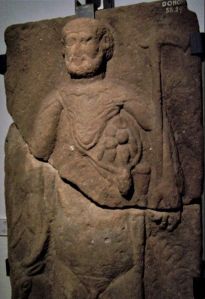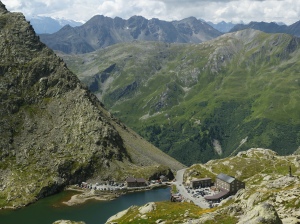Silvanus was a popular god in Rome, up there with Jupiter and Mercury in terms of altars and other devotional evidence. As a god of the common people, he had a large audience, and soldiers, slaves and freedmen to spread his cult abroad.
His popularity worked both ways, too: a British craftsman explained his god Callirius as Silvanus, and many of the other examples in this post could have worked the same way.
Sucellus: was often associated with Silvanus in Germania, and “possibly Belgica” (Dorcey: 58). He was popular enough that we have a sort of standarized image of him: he has a large hammer or mallet, carries a pot or miniature barrel, and has a dog.
A similar deity, called the Mallet or Hammer-God, also appears in southern France, and may or may not be Sucellus. Once again, the southern god was identified with Silvanus. All three seem to have been gods for ordinary people, rather than the aristocracy, carrying the tools of their trades.

Sinquas: known only from two inscriptions, one to Silvanus Sinquas, and one to Sinquas alone. Both inscriptions come from Gérouville, Treveri territory. Each fulfills a vow, and one (to Sinquas alone) was dedicated by someone with the full three names of a Roman citizen. The other was dedicated by someone named Paternius, for the health of his son Emeritus, and invokes Sinquas in his Romanized form as Deo Silvanus Sinquas.
We don’t think of Silvanus as a healing god, but I don’t think that the ancients made these distinctions, or at least that they weren’t as cut and dried as we assume. The Celts seem to have preferred multi-functional deities, and I think that even the Greeks and Romans tended to go to a preferred deity for all their needs.
Vosegus: the Vosges region of France is well-forested, a good spot for hunting. The forest lies in the north-east of France, and becomes the Palatine forest on the other side of the German border. There are inscriptions to Vosegus, Mercury Vosegus and Silvanus Vosgeus. (Six in total, and two to Silvanus.)

From the sanctuary of Donon (Alsace) – a naked god wearing a wolf skin (a variation of Silvanus / Hercules / or Vosegus?) // Dieu nu avec peau de loup // Einheimischer Gott mit Wolfsfell (Musee Strasbourg; photo: R.H.)
The image above shows a man wearing a wolf-skin, carrying a sack filled with almonds and a pinecone (Silvanus’ emblem), carrying a pick and accompanied by a deer instead of his dog.
Intarabus: Vosegus shared his wolf-skin with another regional god, Intarabus. This god, however, was known as Mars Intarabus, when he wasn’t just using his own name. He has eight inscriptions, including one on the base of a statue. That one says In/tara/bo, suggesting the local god rather than the Romanized version.
As you can see from the picture, whatever weapon or attribute he was carrying is lost, so we can’t tell if he’s meant to be Mars (weapon) or not. Deo Mercurio suggests he might be Silvanus, who also wears a wolf-skin. It’s tempting to point to the spell to Mars Silvanus I mentioned in the last post to suggest that Mars and Silvanus were connected through their protective function. However, at least one image of Sucellos/the Hammer-God wears a wolf-skin as well, so there may be a connection there.
Poeninus: if you look up Silvanus on Wikipedia you’ll find Poeninus (of the Pennines) listed as a Gaulish or Germanic deity equated to the forest-god. However, the Gaulish Poeninus was equated with Jupiter Optimus Maximus. We know him from his temple at the Great St. Bernard Pass in the Swiss Alps. (picture below)

St. Bernard’s Pass, Wikimedia.
If you go back to Dorcey’s book on Silvanus, he mentions Silvanus Poininus at Turnovo, in Roman Moesia (the Balkans, now). Dorcey no doubt found his Poininus in the Corpus Inscriptiones Latinorum, which records an inscription that reads (as far as I can make it out):
CIL III: 6143 Silvano Poinino T Ocτλus no nepoi voto aic //// to
However, if you got the Epigraphik Datenbank, you’ll get a rather different result:
CIL III 6143: Silvano Do/mino T(itus) Oc/tavius No/nus pos(uit) votu/m [f]ecit T(—) P(—)
So it would seem that Poininus was just as misunderstanding, and the text actually invokes Silvanus Dominus.
Tettus: another possible Silvanus comes from the following inscription, found at Rheinzabern in Germany:
CIL XIII.1.2: Silvano / Teteo/serus / fi(lius) Tacit(i) / ex voto p(osuit)
However, as Dorcey points out, it could just as easily be the name of the person making the offering, as Tettus was also a Celtic personal name. (Dorcey: 60)
Callirius: is an interesting case, as the one dedication we have to him was made by a British silversmith, who identified him with Silvanus. (RIB 194) The punched bronze plate was probably his own work, and is a textbook example of interpretatio gallica, where the natives equate their own gods to foreign, Roman, ones. Anne Ross and others have linked his name to the Irish word coll, hazel, but Andrew Breeze challenges this, tracing it back to Irish caill and Welsh celli, both words for a forest or grove. The bronze plaque came from a pit in Colchester, along with a bronze stag, a possible link to Vosegus.
WIkipedia says there’s a Romano-British temple dedicated to him. This probably comes from I.A. Richmond’s Roman Britain; he states that a building at Colchester was dedicated to Silvanus Callirius, without giving any sources. (Wright’s report in the Journal of Roman Studies (1947: 178) is more cautious – he simply mentions “the remains of a Roman building”.) Miranda Green says that the plaque and stag came from a pit “in the vicinity” of a Roman shrine (1992: 191), so it’s not clear that the building was dedicated to Callirius, even if it was a shrine.
Cocidius: was a popular god in northern England, with 26 inscriptions. One of these calls him Cocidius Silvanus, while another is dedicated jointly to Cocidius and Silvanus. The altar to Cocidius Silvanus (RIB 1578) was dedicated by the the prefect of a cohort of Tungrian soldiers. (Tungrians came from the modern Netherlands, and they gave auxillary units to Rome as a sort of tribute.) The other altar (RIB 1207) was used later for masonry, so we don’t know who dedicated it.
Vinotonus: is another northerner, with two temples dedicated to him on Scargill Moor in County Durham. One was round, the other rectangular. Archaeologists found six altars dedicated to him, with two dedicated to Vinotonus Silvanus Augustus. One was in the rectangular temple and was dedicated by a centurion (RIB 732), the other was found halfway between the two temples, and the prefect of the same cohort dedicated it. (RIB 3251)
Vinotonus’ name probably comes from the local stream or the place itself. The other possibility, that his name relates to words for vine, seems less likely.
Calaedicus: was a Spanish god, from Tarraconensis. It might be part of the dedicator’s name, but if it is a god, his name means “of the rocky refuge that burns”. (Dorcey: 63) In Aquitania and elsewhere Silvanus became a patron god of quarriers, so this is not as far-fetched as it may seem.
Maglae/Maglaenus: is a Pannonian (parts of Eastern and South-Eastern Europe) name for Silvanus, possibly meaning “boy”. It comes from two inscriptions:
AEA 2005, 00095: S(ilvano) D(omestico) s(acrum) et / Magl(a)e / Sep(timius) Val[3] / [3]p [et] / [Se]p(timia) Val[3] / [3] filia / [
CIL 03, 03963: Silvano / Maglae / Longinia / Ingenua
It doesn’t help us to know who or what the Maglae was, or were, but the title Domesticus seems to hint that Silvanus was being invoked as a protector of household, so it makes sense that Maglae had similar powers.
References:
Breeze, Andrew 2004: “The God Silvanus Callirius and RIB 194, from Colchester,” Britannia 35: 228-9. (Cambridge University Press: first page)
Dorcey, Peter 1992: The Cult of Silvanus: a Study in Folk Religion, Brill. (Google Books)
Green, Dorothy (ed) 1947: “Roman Britain,” Yorkshire Archaeological Journal 37: 107-20. (Section on Vinotonus by I.A. Richmond and R.J. Wright: 107- 16) (Internet Archive)
Green, Miranda 1997: Dictonary of Celtic Myth and Legend, Thames and Hudson.




Reblogged this on Die Goldene Landschaft.
LikeLiked by 1 person
It’s fascinating looking at all the localized versions of Silvanus. I wonder what the significance is of the Vosges image showing a deer rather than a dog as his companion?
LikeLiked by 1 person
It’s an interesting question – some see it as a connection to Cernunnos, probably because they both govern wild nature. But I think the deer could be Silvanus’ own animal, and his hand resting on it could show his protection of wild animals.
LikeLiked by 1 person
That’s an interesting take. I wondered if it might show a less aggressive nature, though your point about “wild animals” makes me look at the dog in a different light. Dogs are, after all, ultimately domestic, whereas deer are both wild and a commonly hunted animal. They would be an ideal symbol for protecting wild spaces.
LikeLiked by 1 person